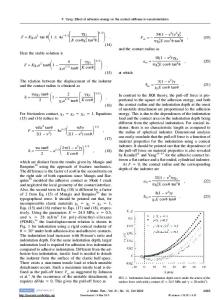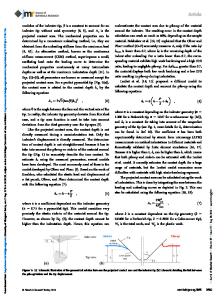On the generality of the relationship among contact stiffness, contact area, and elastic modulus during indentation
- PDF / 414,623 Bytes
- 5 Pages / 576 x 792 pts Page_size
- 18 Downloads / 415 Views
W. C. Oliver Metals and Ceramics Division, Oak Ridge National Laboratory, Oak Ridge, Tennessee 37831
F. R. Brotzen Department of Materials Science, Rice University, P. O. Box 1982, Houston, Texas 77251 (Received 20 September 1991; accepted 8 November 1991)
Results of Sneddon's analysis for the elastic contact between a rigid, axisymmetric punch and an elastic half space are used to show that a simple relationship exists among the contact stiffness, the contact area, and the elastic modulus that is not dependent on the geometry of the punch. The generality of the relationship has important implications for the measurement of mechanical properties using load and depth sensing indentation techniques and in the measurement of small contact areas such as those encountered in atomic force microscopy.
I. INTRODUCTION Load and displacement sensing indentation techniques are becoming increasingly popular for measuring the elastic moduli of thin films and small volumes.1"9 The techniques rely on the fact that the displacements recovered during unloading are largely elastic, in which case elastic punch theory can be used to determine the modulus, E, from simple analyses of indentation loaddisplacement data. Referring to the schematic plot of indentation load, P, vs displacement, h, in Fig. 1, one
popular method relates E to the initial unloading stiffness, S = dP/dh. The basic assumption is that during the initial withdrawal of the indenter, the contact area between the indenter and the specimen remains constant, in which case the analysis of Sneddon for the indentation of an elastic half space by a flat, cylindrical punch approximates the behavior.10 Sneddon's analysis leads to a simple relation between P and H of the form P =
h
(1)
where a is the radius of the cylinder, \x is the shear modulus, and v is Poisson's ratio. Noting that the area of the contact circle, ^4, is simply ira2 (i.e., the area of the contact projected into the surface) and that the shear modulus can be related to the elastic modulus through E = 2/i (1 + v), differentiating P with respect to h leads to LOADING
E
dP dh
(1 -
(2)
Q
It is thus seen that the modulus can be computed directly from the initial unloading slope, provided a reasonable estimate of Poisson's ratio and an independent measure of the contact area are available. In the case that the indenter itself has finite elastic constants, Et and uh so that deformation of the indenter contributes to the measured displacement, it is convenient to define a reduced modulus, Er,
UNLOADING
DISPLACEMENT, h FIG. 1. Typical indentation load-displacement data. J. Mater. Res., Vol. 7, No. 3, Mar 1992 http://journals.cambridge.org
Downloaded: 30 Sep 2014
(3)
E © 1992 Materials Research Society
613 IP address: 129.186.1.55
G. M. Pharr, W. C. Oliver, and F. R. Brotzen: On the generality of the relationship among contact stiffness, contact area, and elastic modulus
(see, for example, Stillwell and Tabor11), for which Eq. (2) becomes
QUARTZ v. \
SODA LIME GLASS
100 :
(4)
ah
//
It is im
Data Loading...











